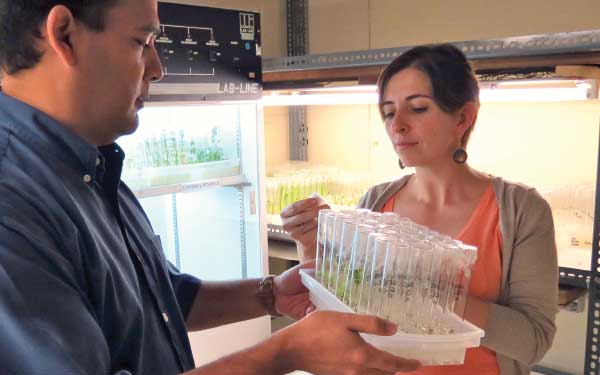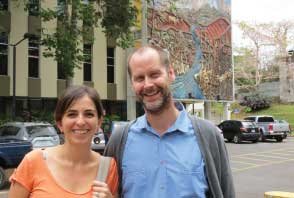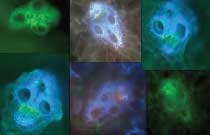
Ensuring the Safety of Grain in the Tropics
Adriana Murillo Williams’ lab looks over rice – and other important food crops – grown in or imported to Costa Rica before they land on people’s plates.
“Rice is our staple food. We check for toxins harmful to human health – aflatoxins – and other impurities and make sure what is on the bag is actually what’s inside,” she says.
Testing grain quality is one part of Williams’ (MS ’04 crop production and physiology, PhD ‘07) role as director of the University of Costa Rica Center for Research in Grains and Seeds (CIGRAS). She oversees the divisions of the research center – biotechnology, grain analysis, mycotoxin analysis, agricultural processes and seed analysis.
Opening the door to the center during a recent visit, visitors are hit with the smell of nutmeg. The spice is being tested for safety and quality before export. The lab provides services in quality analysis of seeds and grains for the public and private sector.
An expert in seed pathology, physiology and production, Williams focuses on how rice, dry beans and corn are affected by mycotoxins (toxic fungus). She has presented internationally on the impact
of climate change on mycotixins.
Williams coordinates graduate student seminars and teaches courses on plant physiology for the University of Costa Rica as part of her work with the center. The university’s enrollment is around 30,000. CIGRAS also holds training for agribusinesses, farmers and consumers.
Williams grew up five minutes from the city center of San Jose. The capital city, with a population of more than 280,000, is far from an agrarian center. Her interest in crop production began at home as the daughter of two microbiologists.
“I loved plants and wanted to know all about how they grow and develop ever since my father explained to me how a seed works,” Williams says. She looked to Iowa State to further her education at the recommendation of her professors. Williams knew she would return to her home country after completing her Iowa State degrees. “I wanted to contribute to my country by teaching and mentoring students, sharing what I learned,” she says.

Adriana Murrillo Williams is the director of the Center for Research in Grains and Seeds in San Jose, Costa Rica. She and husband Paul Esker, a fellow Iowa Stater, are professors at the University of Costa Rica where a mural depicting Costa Rican agriculture welcomes visitors.
She met her husband Paul Esker (MS ’01 plant pathology, PhD ’05 statistics and plant pathology) at Iowa State. An expert in plant disease epidemiology, statistics and field crop diseases, he also is a professor at the University of Costa Rica.
Microscopic Scream
 A few years back while working late at night on her graduate research at Iowa State, Adriana Murillo Williams noticed the colorful patterns appearing through the lens of her microscope. “When it is 10 p.m., and you are by yourself working on the microscope in a dark room a good way to stay awake is to incorporate something fun into the work you are doing,” she says. “Gary Munkvold, my adviser, and I examined several stalk tissues to track down a GFP strain of Fusarium verticillioides. As you can see from my photo, I saved pictures I thought had nice color contrasts or reminded me of other things – in this case, infected vascular bundles reminded me of Edvard Munch’s “The Scream.”
A few years back while working late at night on her graduate research at Iowa State, Adriana Murillo Williams noticed the colorful patterns appearing through the lens of her microscope. “When it is 10 p.m., and you are by yourself working on the microscope in a dark room a good way to stay awake is to incorporate something fun into the work you are doing,” she says. “Gary Munkvold, my adviser, and I examined several stalk tissues to track down a GFP strain of Fusarium verticillioides. As you can see from my photo, I saved pictures I thought had nice color contrasts or reminded me of other things – in this case, infected vascular bundles reminded me of Edvard Munch’s “The Scream.”



